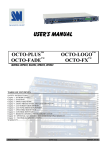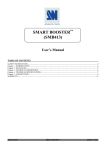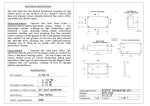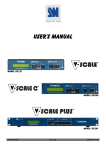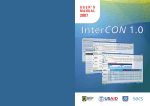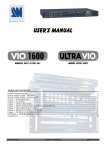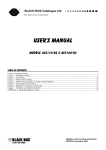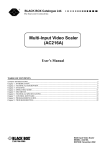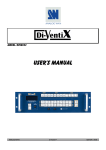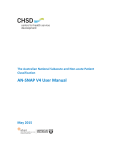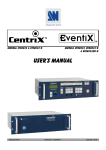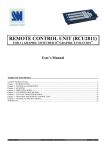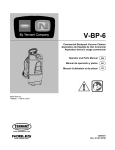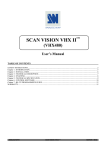Download OCTO-QUATTRO USER`S MANUAL
Transcript
User’s Manual
MODEL: OTR401
TABLE OF CONTENTS
SAFETY INSTRUCTIONS ...........................................................................................................................................................2
Chapter 1 : INTRODUCTION .......................................................................................................................................................5
Chapter 2 : STARTING .................................................................................................................................................................7
Chapter 3 : OPERATING MODE................................................................................................................................................11
Chapter 4 : LCD SCREEN DESCRIPTION ................................................................................................................................12
Chapter 5 : LCD FUNCTIONS DESCRIPTION .........................................................................................................................14
Chapter 6 : UPDATING THE DEVICE ......................................................................................................................................19
Chapter 7 : CONTROL SOFTWARE..........................................................................................................................................20
Chapter 8 : REMOTE CONTROL PROGRAMMER'S GUIDE..................................................................................................23
Chapter 9 : OPTIONAL ACCESSORY: THE REMOTE KEYPAD (RK802-F) ........................................................................29
Chapter 10 : TECHNICAL SPECIFICATIONS ..........................................................................................................................30
WARRANTY...............................................................................................................................................................................33
ANALOG WAY®
OCTO-QUATTRO™
EDITION : 04 / 05
OCTO-QUATTRO™
ENGLISH
SAFETY INSTRUCTIONS
All of the safety and operating instructions should be read before the product is operated and should be retained for further
reference. Please follow all of the warnings on this product and its operating instructions.
CAUTION:
WARNING:
To prevent the risk of electric shock and fire, do not expose this device to rain, humidity or intense
heat sources (such as heaters or direct sunlight). Slots and openings in the device are provided for
ventilation and to avoid overheating. Make sure the device is never placed on or near a textile
surface that could block the openings. Also keep away from excessive dust, vibrations and shocks.
POWER:
Only use the power supply indicated on the device or on the power source. Devices equipped with a
grounding plug should only be used with a grounding type outlet. In no way should this grounding
be modified, avoided or suppressed.
POWER CORD: Use the On (I) / Off (O) switch to power On or Off devices equipped with that switch. All other
devices should be plugged and unplugged from wall outlet. In both cases, please follow these
instructions:
- The power cord of the device should be unplugged from the outlet when left unused for several
days.
- To unplug the device, do not pull on the power cord but always on the plug itself.
- The outlet should always be near the device and easily accessible.
- Power supply cords should be routed so that they are not likely to be walked on or pinched by
items placed upon or against them.
If the power supply cord is damaged, unplug the device. Using the device with a damaged power
supply cord may expose you to electric shocks or other hazards. Verify the condition of the power
supply cords once in a while. Contact your dealer or service center for replacement if damaged.
CONNECTIONS: All inputs and outputs (except for the power input) are TBTS defined under EN60950.
SERVICING:
Do not attempt to service this product yourself by opening or removing covers and screws since it
may expose you to electric shocks or other hazards. Refer all problems to qualified service
personnel.
OPENINGS:
Never push objects of any kind into this product through the openings. If liquids have been spilled or
objects have fallen into the device, unplug it immediately and have it checked by a qualified
technician.
PAGE 2
OCTO-QUATTRO™
INSTRUCTIONS DE SÉCURITÉ
Afin de mieux comprendre le fonctionnement de cet appareil nous vous conseillons de bien lire toutes les consignes de sécurité et de fonctionnement de
l’appareil avant utilisation. Conserver les instructions de sécurité et de fonctionnement afin de pouvoir les consulter ultérieurement. Respecter toutes les
consignes marquées dans la documentation, sur le produit et sur ce document.
INSTALLATION : Veillez à assurer une circulation d’air suffisante pour éviter toute surchauffe à l’intérieur de l’appareil. Ne placez pas l’appareil sur ou
proximité de surface textile susceptible d’obstruer les orifices de ventilation. N’installez pas l’appareil à proximité de sources de chaleur comme un radiateur
ou une bouche d’air chaud, ni dans un endroit exposé au rayonnement solaire direct, à des poussières excessives, à des vibrations ou à des chocs mécaniques.
Ceci pourrait provoquer un mauvais fonctionnement et un accident.
ALIMENTATION : Ne faire fonctionner l’appareil qu’avec la source d’alimentation indiquée sur l’appareil ou sur son bloc alimentation. Pour les appareils
équipés d’une alimentation principale avec fil de terre, ils doivent être obligatoirement connectés sur une source équipée d’une mise à la terre efficace. En
aucun cas cette liaison de terre ne devra être modifiée, contournée ou supprimée.
FRANÇAIS
ATTENTION : Afin de prévenir tout risque de choc électrique et d’incendie, ne pas exposer cet appareil à la pluie, à l’humidité et aux sources de chaleur
intense.
CORDON D’ALIMENTATION : Pour les appareils équipés d’un interrupteur général (Marche I / Arrêt O), la mise sous tension et la mise hors tension se fait
en actionnant cet interrupteur général. Pour les appareils sans interrupteur général, la mise sous tension et la mise hors tension se fait directement en
connectant et déconnectant le cordon d'alimentation de la prise murale.
Dans les 2 cas ci-dessus appliquer les consignes suivantes :
- Débrancher le cordon d'alimentation de la prise murale si vous prévoyez de ne pas utiliser l'appareil pendant quelques jours ou plus.
- Pour débrancher le cordon, tirez le par la fiche. Ne tirez jamais sur le cordon proprement dit.
- La prise d’alimentation doit se trouver à proximité de l’appareil et être aisément accessible.
- Ne laissez pas tomber le cordon d’alimentation et ne posez pas d’objets lourds dessus.
Si le cordon d’alimentation est endommagé, débranchez le immédiatement de la prise murale. Il est dangereux de faire fonctionner cet appareil avec un cordon
endommagé, un câble abîmé peut provoquer un risque d’incendie ou un choc électrique. Vérifier le câble d’alimentation de temps en temps. Contacter votre
revendeur ou le service après vente pour un remplacement.
CONNEXIONS : Toutes les entrées et sorties (exceptée l’entrée secteur) sont de type TBTS (Très Basse Tension de Sécurité) définies selon EN 60950.
RÉPARATION ET MAINTENANCE : L’utilisateur ne doit en aucun cas essayer de procéder aux opérations de dépannage, car l’ouverture des appareils par
retrait des capots ou de toutes autres pièces constituant les boîtiers ainsi que le dévissage des vis apparentes à l’extérieur, risque d’exposer l’utilisateur à des
chocs électriques ou autres dangers. Contacter le service après vente ou votre revendeur ou s’adresser à un personnel qualifié uniquement.
OUVERTURES ET ORIFICES : Les appareils peuvent comporter des ouvertures (aération, fentes, etc...), veuillez ne jamais y introduire d’objets et ne jamais
obstruer ses ouvertures. Si un liquide ou un objet pénètre à l’intérieur de l’appareil, débranchez immédiatement l’appareil et faites le contrôler par un personnel
qualifié avant de le remettre en service.
Allo scopo di capire meglio il funzionamento di questa apparecchiatura vi consigliamo di leggere bene tutti i consigli di sicurezza e di funzionamento prima
dell’utilizzo. Conservare le istruzioni di sicurezza e di funzionamento al fine di poterle consultare ulteriormente. Seguire tutti i consigli indicati su questo
manuale e sull’apparecchiatura.
ATTENZIONE : Al fine di prevenire qualsiasi rischio di shock elettrico e d’incendio, non esporre l’apparecchiatura a pioggia, umidità e a sorgenti di
eccessivo calore.
INSTALLAZIONE : Assicuratevi che vi sia una sufficiente circolazione d’aria per evitare qualsiasi surriscaldamento all’interno dell’apparecchiatura. Non
collocare l’apparecchiatura in prossimità o su superfici tessili suscettibili di ostruire il funzionamento della ventilazione. Non installate l’apparecchiatura in
prossimità di sorgenti di calore come un radiatore o una fuoruscita d’aria calda, né in un posto esposto direttamente ai raggi del sole, a polvere eccessiva, a
vibrazioni o a shock meccanici. Ció potrebbe provocare un erroneo funzionamento e un incidente.
ALIMENTAZIONE : Far funzionare l’apparecchiatura solo con la sorgente d’alimentazione indicata sull’apparecchiatura o sul suo alimentatore. Per le
apparecchiature fornite di un’alimentazione principale con cavo di terra, queste devono essere obbligatoriamente collegate su una sorgente fornita di una
efficiente messa a terra. In nessun caso questo collegamento potrà essere modificato, sostituito o eliminato.
CAVO DI ALIMENTAZIONE : Per le apparecchiature fornite di interruttore generale (Acceso I / Spento O), l’accensione e lo spegnimento
dell’apparecchiatura si effettuano attraverso l’interruttore. Per le apparecchiature senza interruttore generale, l’accensione e lo spegnimento si effettuano
direttamente inserendo o disinserendo la spina del cavo nella presa murale.
In entrambe i casi applicare i seguenti consigli :
- Disconnettere l’apparecchiatura dalla presa murale se si prevede di non utilizzarla per qualche giorno.
- Per disconnettere il cavo tirare facendo forza sul connettore.
- La presa d’alimentazione deve trovarsi in prossimità dell’apparecchiatura ed essere facilmente accessibile.
- Non far cadere il cavo di alimentazione né appoggiarci sopra degli oggetti pesanti.
Se il cavo di alimentazione é danneggiato, spegnere immediatamente l’apparecchiatura. E’ pericoloso far funzionare questa apparecchiatura con un cavo di
alimentazione danneggiato, un cavo graffiato puó provocare un rischio di incendio o uno shock elettrico. Verificare il cavo di alimentazione spesso. Contattare
il vostro rivenditore o il servizio assistenza per una sostituzione.
CONNESSIONE : Tutti gli ingressi e le uscite (eccetto l’alimentazione) sono di tipo TBTS definite secondo EN 60950.
RIPARAZIONI E ASSISTENZA : L’utilizzatore non deve in nessun caso cercare di riparare l’apparecchiatura, poiché con l’apertura del coperchio metallico
o di qualsiasi altro pezzo costituente la scatola metallica, nonché svitare le viti che appaiono esteriormente, poiché ció puó provocare all’utilizzatore un
rischio di shock elettrico o altri rischi.
APERTURE DI VENTILAZIONE : Le apparecchiature possono comportare delle aperture di ventilazione, si prega di non introdurre mai oggetti o ostruire le
sue fessure. Se un liquido o un oggetto penetra all’interno dell’apparecchiatura, disconnetterla e farla controllare da personale qualificato prima di rimetterla in
servizio.
PAGE 3
ITALIANO
ISTRUZIONI DI SICUREZZA
OCTO-QUATTRO™
SICHERHEITSHINWEISE
Um den Betrieb dieses Geräts zu verstehen, raten wir Ihnen vor der Inbetriebnahme alle Sicherheits und Betriebsanweisungen genau zu lesen. Diese
Sicherheits- und Betriebsanweisungen für einen späteren Gebrauch sicher aufbewahren. Alle in den Unterlagen, an dem Gerät und hier angegebenen
Sicherheitsanweisungen einhalten.
VORSICHT & WARNUNG
ACHTUNG: um jegliches Risiko eines Stromschlags oder Feuers zu vermeiden, das Gerät nicht Regen, Feuchtigkeit oder intensiven Wärmequellen aussetzen.
EINBAU : Eine ausreichende Luftzufuhr sicherstellen, um jegliche Überhitzung im Gerät zu vermeiden. Das Gerät nicht auf und in Nähe von
Textiloberflächen, die Belüftungsöffnungen verschließen können, aufstellen. Das Gerät nicht in Nähe von Wärmequellen, wie z.B. Heizkörper oder
Warmluftkappe, aufstellen und es nicht dem direkten Sonnenlicht,übermäßigem Staub, Vibrationen oder mechanischen Stößen aussetzen. Dies kann zu
Betriebsstörungen und Unfällen führen.
DEUTSCH
STROMVERSORGUNG : Das Gerät nur mit der auf dem Gerät oder dem Netzteil angegebenen Netzspannung betreiben. Geräte mit geerdeter
Hauptstromversorgung müssen an eine Stromquelle mit effizienter Erdung angeschlossen werden. Diese Erdung darf auf keinen Fall geändert, umgangen oder
entfernt werden.
STROMKABEL : Für Geräte mit einem Hauptschalter (Ein/Aus) erfolgt die Stromversorgung und unterbrechung mittels dieses Hauptschalters. Geräte ohne
Hauptschalter werden durch das Einstecken oder Herausziehen des Steckers in den Wandanschluß ein- oder ausgeschaltet. Für beide Fälle gelten folgende
Richtlinien :
- Den Stecker aus dem Wandanschluß herausziehen wenn Sie das Gerät mehrere Tage oder länger nicht benutzen.
- Das Kabel mittels dem Stecker herausziehen. Niemals am Stromkabel selbst ziehen.
- Die Steckdose muß sich in der Nähe des Geräts befinden und leicht zugänglich sein.
- Das Stromkabel nicht fallen lassen und keine schweren Gegenstände auf es stellen.
Wenn das Stromkabel beschädigt ist, das Gerät sofort abschalten. Es ist gefährlich das Gerät mit einem beschädigten Stromkabel zu betreiben; ein abgenutztes
Kabel kann zu einem Feuer oder Stromschlag führen. Das Stromkabel regelmäßig untersuchen. Für den Ersatz, wenden Sie sich an Ihren Verkäufer oder
Kundendienststelle.
ANSCHLÜSSE : Bei allen Ein- und Ausgängen (außer der Stromversorgung) handelt es sich, gemäß EN 60950, um Sicherheits Kleinspannunganschlüsse.
REPARATUE UND WARTUNG : Der Benutzer darf keinesfalls versuchen das Gerät selbst zu reparieren, die Öffnung des Geräts durch Abnahme der
Abdeckhaube oder jeglichen anderen Teils des Gehäuses sowie die Entfernung von außen sichtbaren Schrauben zu Stromschlägen oder anderenGefahren für
den Benutzer führen kann. Wenden Sie sich an Ihren Verkäufer, Ihre Kundendienststelle oder an qualifizierte Fachkräfte.
ÖFFNUNGEN UND MUNDUNGEN : Die Geräte können über Öffnungen verfügen (Belüftung, Schlitze, usw.). Niemals Gegenstände in die Öffnungen
einführen oder die Öffnungen verschließen. Wenn eine Flüssigkeit oder ein Gegenstand in das Gerät gelangt, den Stecker herausziehen und es vor einer neuen
Inbetriebnahme von qualifiziertem Fachpersonal überprüfen lassen.
INSTRUCCIONES DE SEGURIDAD
Para comprender mejor el funcionamiento de este aparato, le recomendamos que lea cuidadosamente todas las consignas de seguridad y de funcionamiento del
aparato antes de usarlo. Conserve las instrucciones de seguridad y de funcionamiento para que pueda consultarlas posteriormente. Respete todas las consignas
indicadas en la documentación, relacionadas con el producto y este documento.
PRECAUCIONES Y OBSERVACIONES
ESPAÑOL
CUIDADO : Para prevenir cualquier riesgo de choque eléctrico y de incendio, no exponga este aparato a la lluvia, a la humedad ni a fuentes de calorintensas.
INSTALACIÓN : Cerciórese de que haya una circulación de aire suficiente para evitar cualquier sobrecalentamiento al interior del aparato. No coloque el
aparato cerca ni sobre una superficie textil que pudiera obstruir los orificios de ventilación. No instale el aparato cerca de fuentes de calor como radiador o
boca de aire caliente, ni en un lugar expuesto a los rayos solares directos o al polvo excesivo, a las vibraciones o a los choques mecánicos. Esto podría
provocar su mal funcionamiento o un accidente.
ALIMENTACIÓN : Ponga a funcionar el aparato únicamente con la fuente de alimentación que se indica en el aparato o en su bloque de alimentación. Los
aparatos equipados con una alimentación principal con hilo de tierra deben estar conectados obligatoriamente a una fuente equipada con una puesta a tierra
eficaz. Por ningún motivo este enlace de tierra deberá ser modificado, cambiado o suprimido.
CABLE DE ALIMENTACIÓN : Para los aparatos equipados con un interruptor general (Marcha I / Paro O), la puesta bajo tensión y la puesta fuera de tensión
se hace accionando este interruptor general.. En los aparatos que no tienen interruptor general, la puesta bajo tensión y la puesta fuera de tensión se hace
directamente conectando y desconectando el enchufe mural.
En ambos casos, se deberá respetar las siguientes consignas:
- Desconectar el aparato del enchufe mural si no piensa utilizarlo durante varios días.
- Para desconectar el cable, tire de la clavija. No tire nunca del cable propiamente dicho.
- El enchufe de alimentación debe estar cerca del aparato y ser de fácil acceso.
- No deje caer el cable de alimentación ni coloque objetos pesados encima de él.
Si el cable de alimentación sufriera algún daño, ponga el aparato inmediatamente fuera de tensión. Es peligroso hacer funcionar este aparato con un cable
averiado, ya que un cable dañado puede provocar un incendio o un choque eléctrico. Verifique el estado del cable de alimentación de vez en cuando. Póngase
en contacto con su distribuidor o con el servicio de posventa si necesita cambiarlo.
CONEXIONES : Todas las entradas y salidas (excepto la entrada del sector) son de tipo TBTS (Muy Baja Tensión de Seguridad) definidas según EN 60950.
REPARACIÓN Y MANTENIMIENTO : Por ningún motivo, el usuario deberá tratar de efectuar operaciones de reparación, ya que si abre los aparatos
retirando el capó o cualquier otra pieza que forma parte de las cajas o si destornilla los tornillos aparentes exteriores, existe el riesgo de producirse una
explosión, choques eléctricos o cualquier otro incidente. Contacte el servicio de posventa, a su distribuidor o dirigirse con personal cualificado únicamente.
ABERTURAS Y ORIFICIOS : Los aparatos pueden contener aberturas (aireación, ranuras, etc.). No introduzca allí ningún objeto ni obstruya nunca estas
aberturas. Si un líquido o un objeto penetra al interior del aparato, desconéctelo y hágalo revisar por personal cualificado antes de ponerlo nuevamente en
servicio.
PAGE 4
OCTO-QUATTRO™
ENGLISH
OCTO-QUATTRO™
Chapter 1 : INTRODUCTION
1-1. ACCESSORIES SUPPLIED WITH YOUR DEVICE
• 1 AC Power supply cord.
• 1 VGA cable (HD15 male / male connector).
• 1 S.VIDEO (Y/C) cable (4-pin mini DIN male / 2 BNC male connectors).
• 1 Set of 5 MCO (5-pin) female connectors (for audio connection).
• 2 white labels: to rename the input selection buttons.
• 1 CD-ROM (Remote Control Software).
• 1 User’s Manual.
1-2. GENERAL INFORMATION
The OCTO-QUATTRO™ is a computer & video up/down Scaler Switcher with 4 universal A/V inputs. It performs
an ultra fast and smooth transition between any scaled sources.
Each of the 4 inputs is fitted with a stereo audio line. The audio can either follow or break down from the video
image. The volume of each audio can be individually adjusted.
The OCTO-QUATTRO™ can fit with the native resolution of the projection display and provide you with a high
image quality thanks to its integrated digital decoder, improved 3:2 and 2:2 Pull down circuitry, auto-adaptative
pixel by pixel 3D motion compression, Time Base Corrector. All individual image controls settings are stored in
non-volatile memories. This compact device is especially dedicated to the installation market, for entry level High
Resolution A/V Seamless presentation displays, conference and boardrooms.
Easy to use, the OCTO-QUATTRO™, offers auto Image centering, Auto pixel clock, Auto scan. Also an auto
projector ON/OFF through RS232 control and a jack Ø 3,5 mm powered by a +12 Vdc output, is provided.
1-3. DEVICES & OPTIONS REFERENCES
REFERENCE
OTR401
OPT-LAN
RK802-F
10077
10023
10102
10009
10123
10124
DESIGNATION
OCTO-QUATTRO™.
LAN communication port (optional)
Remote KEYPAD for controlling an OCTO device (optional).
CABLE (HD15 M / HD15 M) L = 1.8 m
CABLE (HD15 M / 5BNC M) L = 1.8 m
CABLE (4-pin mini DIN M / 2BNC M) L = 1.8 m
CABLE (4-pin mini DIN M / 4-pin mini DIN M) L = 1.2 m (optional).
CABLE (HD15 M / 5BNC F) L = 0.5 m (optional).
CABLE (4-pin mini DIN F / HD15 M) L = 0.2 m (optional).
1-4. INSTALLATION
IMPORTANT:
Please read all the safety instructions (pages 2 to 4) before starting.
• Table Top Mounting: The OCTO-QUATTRO™ can be used directly on a table: the unit is equipped with 4 plastic
feet.
• Rack Mounting:
The OCTO-QUATTRO™ is compatible with a 19" enclosure. To install the OCTOQUATTRO™ into a 19” rack: Attach the OCTO-QUATTRO™ to the rack by using 4 screws in
the front panel holes (screws are not included).
IMPORTANT:
• The openings in the rear and side panels are for cooling. Do not cover these openings.
• Be sure that no weight is added to the OCTO-QUATTRO™ in excess of 2 kg (4.4 lbs.).
• The maximum ambient operating temperature must not exceed 40°C (104°F).
• The rack and all mounted equipment in it must be reliably grounded to national and
local electrical codes.
PAGE 5
Chapter 1 : INTRODUCTION (continued)
OCTO-QUATTRO™
1-5. REAR PANEL DESCRIPTION
POWER:
Standard IEC connector (100-250 VAC, 1A, 50-60 Hz automatic).
LAN:
LAN communication port on a RJ45 connector (optional).
COMPUTER & VIDEO INPUTS:
4 Universal (computer and video) inputs.
INPUTS #1 & 2:
Computer, YUV and HDTV signals on the HD15 female input connector.
S.VIDEO (Y/C) signal on 2 BNC input connectors (Y & C).
Composite Video on one BNC input connector (C.V).
INPUTS # 3 & 4:
All signals on a HD15 female connector.
DISPLAY OUT:
DATA output (RGBHV, RGB/S or RGsB) on HD15 female connector.
ROOM OUT:
A room (+ 12 Vdc trigger) command output (3.5 mm jack female), allows to
control external functions such as up/down screen, lighting...
AUDIO IN:
1 to 4:
Audio stereo input balanced/unbalanced on a 5-pin MCO male connector.
AUDIO OUT:
Audio stereo output balanced/unbalanced on a 5-pin MCO male connector.
RS-232:
RS-232 communication port on a DB9 female connector.
1-6. FRONT PANEL DESCRIPTION
INPUT SELECTION:
Selection of the 4 input sources.
BLACK:
Allows to display a BLACK screen onto the output (the blinking LED indicates that this
function is active).
FREEZE:
Allows to freeze the displayed output (the blinking LED indicates the FREEZE is active).
IMAGE CENTERING:
Allows to automatically position the image in the centering pattern.
LCD CONTROL
EXIT MENU:
ENTER:
ON / OFF:
PAGE 6
Allows to scroll thru the different menus (in Control mode) or to adjust the master volume
(in Status mode).
Switches between Status and Control mode.
Validates a selected item.
AC power switch (O = OFF, I = ON).
OCTO-QUATTRO™
Chapter 2 : STARTING
2-1. CONNECTIONS
c Turn OFF all of your equipment before connecting.
d Connect the AC Power supply cord to the OCTO-QUATTRO™ and to an AC power outlet.
e Connect your Computer and video sources to the 4 inputs of the OCTO-QUATTRO™. See next paragraphs for
more information.
f Connect all of your audio sources to the corresponding AUDIO IN connectors.
g Connect the AUDIO OUT connector to your sound system.
h Connect the DISPLAY OUT connector to the DATA INPUT of your display device (data projector, plasma
screen...).
i If needed, connect your control device or the remote keypad to the RS-232 connector.
j Turn ON the OCTO-QUATTRO™ (front panel switch). Then turn ON all yours input sources, and then your
display device.
NOTE: For switching operation please see Chapter 3 : OPERATING MODE.
PAGE 7
Chapter 2 : STARTING (continued)
OCTO-QUATTRO™
2-2. COMPOSITE VIDEO SOURCES
The Composite Video signal, usually called COMPOSITE or VIDEO is available on most video equipment (VCR, DVD,
CAMERA…), but it is also the lowest in picture quality. The video standard of this signal could be NTSC, PAL or
SECAM. The signal is transmitted by a single coaxial cable, and is connected to the video equipment with an RCA or BNC
connector.
2-3. S.VIDEO SOURCES
The S.VIDEO signal, also called Y/C, HI-8™, or S.VHS™, is available on most DVD players and high quality VCR
(S.VHS). The S.VIDEO signal, in which the Luminance (Y) and Chrominance (C) information are separately transmitted
(2 wires), gives a higher quality picture than the Composite video signal. The S.VIDEO connector is usually a 4-pin
Mini-DIN connector also called Oshiden™ connector. It can also sometimes be on 2 BNC connectors.
PAGE 8
OCTO-QUATTRO™
Chapter 2 : STARTING (continued)
2-4. RGB/S VIDEO SOURCES
The RGB/S signal, also called RGB Sync., is an RGB signal with COMPOSITE Sync. This signal is widely used in
broadcasting. The RGB/S signal is transmitted with 4 coaxial cables, and it has a better picture quality than COMPOSITE
or S.VIDEO signals. The RGB/S connectors are usually BNC connectors.
2-5. COMPONENT VIDEO SOURCES (YUV)
The Component Video signal, also called YUV (Y, R-Y, B-Y), or BETACAM™, is widely used in broadcasting and is
available on high-quality DVD players. The COMPONENT signal is transmitted with 3 coaxial cables, and also has a
better picture quality than COMPOSITE and S.VIDEO signals. The COMPONENT connectors are usually RCA (x3), or
BNC (x3) connectors.
2-6. HDTV SOURCES
The OCTO-QUATTRO™ accepts the 720p, 1035i and 1080i HDTV formats. Connect your HDTV sources as a component
source.
2-7. COMPUTER SOURCES
The OCTO-QUATTRO™ accepts COMPUTER signals (RGBHV, RGB/S, and RGsB) on its 4 inputs connector (HD15
female). Use a HD15 male / male cable to connect each of your computer sources to the inputs of the OCTO-QUATTRO™.
For MAC and WORKSTATION you may require some adapters.
PAGE 9
Chapter 2 : STARTING (continued)
OCTO-QUATTRO™
2-8. DISPLAY OUTPUT
The OCTO-QUATTRO™ is equipped with a data outputs on HD15 female connector. The OCTO-QUATTRO™ can
provide an RGBHV (H & V Separate Sync.), an RGB/S (Composite Sync.) or a RGsB (SOG) output signal.
2-9. AUDIO INPUTS
Each audio is equipped with a 5-pin MCO male connector. This connector allows connecting BALANCED or
UNBALANCED audio inputs. Connect your audio sources as follow:
2-10. AUDIO OUTPUT
The audio output is equipped with a 5-pin MCO male connector. This connector allows connecting BALANCED or
UNBALANCED audio systems.
PAGE 10
OCTO-QUATTRO™
Chapter 3 : OPERATING MODE
3-1. SETTINGS
c We recommend resetting the OCTO-QUATTRO™ device to all of its default values, with the LCD menu
(CONTROL > default value > yes) before proceeding.
d Select the input type connected to the INPUTS (#1 to #4) with the LCD menu (INPUT >input type).
e Select the output sync. which corresponds to your display device with the LCD menu (OUTPUT > output sync).
f Select an output rate mode with the LCD menu (SWITCHING > fast switching > output rate > internal or
follow).
g Select one of the output formats with the LCD menu (OUTPUT > output format).
NOTE: For fixed pixels display device (DMD, LCD, PLASMA…), always select the output format corresponding
to the native resolution of your display device. Thus, the display device will not have to scale the image and
the result will be better.
h Select the type of screen (4/3 or 16/9) with the LCD menu (OUTPUT > type of screen), according to your wall
mounted projection screen shape.
3-2. SWITCHING OPERATIONS
The OCTO-QUATTRO™ allows switching between its inputs with 2 different manner: with a FADE COLOR or with
a CLEAN CUT. The FADE COLOR allows to switch between the 2 sources with a fading to the color of you choice.
NOTE: You can select the color of the fading with the LCD menu (CONTROL > transition > fade color).
The CLEAN CUT allows a clean switching thanks to a fast freeze of the displayed source. Activate the CLEAN CUT
with the LCD menu (CONTROLS > transition > clean cut).
3-3. DISPLAY DEVICE ADJUSTMENTS
c Display a black output (with the front panel BLACK button).
d Display the centering pattern with the LCD menu (OUTPUT > test pattern > centering).
e Adjust directly the display device itself, using its position and size controls, to fill the centering pattern in full
screen.
3-4. IMAGE ADJUSTMENTS
For each input source connected to the OCTO-QUATTRO™, make the following adjustments:
c Select the source you want to adjust (with the front panel "INPUT SELECTION" buttons).
d Select the aspect ratio of your input source with the LCD menu (IMAGE > aspect ratio).
e Use the Centering function (IMAGE > centering) to automatically position the image in the Centering pattern.
IMPORTANT: For best results, display a full size bright image (no black border) to perform a centering. If
necessary, correct the adjustment with the position & size functions (IMAGE > pos settings).
NOTE: The centering function is only available for computer sources.
NOTE: In case of same Input/Output resolution, the centering also achieves automatic pixel clock adjustments. It
may be useful, to improve manually the pixel clock and phase using the LCD menu (IMAGE > optimize
> clock or phase).
f If needed, make the others adjustments, available in the LCD IMAGE menu (color, brightness…).
NOTE: To set the image adjustments to the factory settings, use the Preset function (IMAGE > preset > yes).
NOTE: The adjustments are automatically stored in NON-volatile memories. The OCTO-QUATTRO™ is provided
with 40 NON-volatile image memories. Each of these memories contains the input channel number, the
input and output format parameters and all of the image adjustments (position, size, brightness...). When
the 40 memories are used, each new memorization erases the oldest record.
3-5. AUDIO ADJUSTMENTS
c Adjust the master volume (AUDIO > master volume).
d Set the auto follow or breakaway audio mode (AUDIO > audio source > auto follow or input # x):
- auto follow = the audio switching follows automatically the video switching.
- breakaway = the selected audio input is permanently diffused.
e For each audio input, adjust the level (AUDIO > audio level) and the balance (AUDIO > audio balance).
PAGE 11
OCTO-QUATTRO™
Chapter 4 : LCD SCREEN DESCRIPTION
4-1. INTRODUCTION
The LCD screen is composed of 2 modes: the STATUS MODE and the CONTROL MODE.
• The STATUS MODE indicates the input and output status of the OCTO-QUATTRO™.
• The CONTROL MODE allows selecting and adjusting the parameters of the OCTO-QUATTRO™.
4-2. CONTROL BUTTONS
The LCD screen is controlled by 2 buttons and 1 knob:
knob:
• In the STATUS MODE, turns this knob to adjust the Master volume.
• In the CONTROL MODE, turn this knob to scroll thru the different menus.
EXIT / MENU button:
• In the STATUS MODE, press this button to display the CONTROL MODE.
• In the CONTROL MODE, press this button to:
- return to the previous menu without safeguarding the selection.
- return to the STATUS MODE (press several times).
ENTER button:
• From the STATUS MODE, press this button to display the CONTROL MODE.
• From the CONTROL MODE, press this button to confirm a selected item.
4-3. STATUS MODE
When switching ON, the LCD SCREEN shows the product's name and reference as follows:
DEVICE NAME
OCTO-QUATTRO
DEVICE VERSION
c
Version _._
OUTPUT
XGA
d
intern rate
60 Hz
e
f
g
INPUT # 1
SVGA
37.9 K / 60Hz
c OUTPUT RATE.
d OUTPUT FORMAT.
e OUTPUT FRAME RATE.
f SELECTED INPUT (DISPLAYED).
g INPUT FORMAT OR INPUT STANDARD.
h INPUT LINE / FRAME FREQUENCY.
PAGE 12
DEVICE STATUS
OUTPUT STATUS
INPUT STATUS
h
OCTO-QUATTRO™
Chapter 4 : LCD SCREEN DESCRIPTION (continued)
4-4. CONTROL MODE
The menus of the CONTROL MODE are configured as follow:
1 INPUT
1 input status
2 input type
3 used input
4 H. sync. load
5 VCR mode
2 OUTPUT
1 #1 Comp.
2 #2 Comp.
3 #3 Comp.
4 #4 Comp.
5 All inputs
1 SDTV Composite
2 SDTV S.VIDEO
3 SDTV YUV
4 SDTV RGBS TTL
5 SDTV RGB SOG
6 SDTV RGBS ana.
7 Computer SOG
8 Computer HV/C
9 HDTV
10 Audio only.
HV/C
HV/C
HV/C
HV/C
1 Input # 1
2 Input # 2
3 Input # 3
1 used
2 unused
1 output status
2 output format
1 640x480L
2 800x600L
3 1024x768L
4 1280x1024L
5 1365x1024L
6 1365x768L
7 HDTV 480p
8 HDTV 720p
3 output sync
1 screen 4/3
2 screen 16/9
5 test pattern
1 no pattern
2 centering
3 color bar
1 fast switching
4 IMAGE
1 centering
2 pos settings
3 aspect ratio
4 H. smooth
5 AUDIO
1
2
3
4
5
master volume
audio source
audio level
audio balance
mute off
6 CONTROL
1 versions
2 key locking
3 transition
1
2
3
4
I
N
T
E
R
N
A
L
R
A
T
E
H. position
V. position
H. size
V. size
1 4/3 standard
2 16/9 letterbox
3 WS anamorphic
IF COMPUTER INPUT
5 black level
6 color
1 Red level
2 Green level
3 Bleu level
7 optimize
8 preset
1 clock
2 phase
1 auto follow
2 input # 1
…..
5 input # 4
1 red level
2 green level
3 bleu level
1 fade color
2 clean cut
1 from computer
2 from video
3 from all
4 display ON/OFF
1 baud rate
2 message ON
3 message OFF
4 reset messages
5 timer
6 switch off
5 2:2 pull down
auto
6 RS232/LAN port
7 LAN setup
R
A
T
E
1 VGA 60Hz 4/3
2 SVGA 60Hz 4/3
3 XGA 60Hz 4/3
4 SXGA 60Hz 4/3
5 SXGA+ 60Hz 4/3
6 VGA 75Hz 4/3
7 SVGA 75Hz 4/3
8 XGA 75Hz 4/3
9 SXGA 75Hz 4/3
10 D-ILA 75Hz 4/3
11 D-ILA 75Hz 16/9
12 HDTV 480p
13 HDTV 720p
output rate
[ internal ]
[ input #1 ]
…..
[ input #4 ]
IF VIDEO INPUT
5 brightness
6 contrast
7 color
8 hue
9 under/over
10 sharpness
11 preset
I
N
P
U
T
output sync
H&V COMP SOG
4 type of screen
3 SWITCHING
1 NTSC/PAL/SECAM
2 NTSC
3 NTSC 4,43 60Hz
4 PAL
5 PAL 4,43 60 Hz
6 SECAM
7 B&W 50/60Hz
off
comm port select
RS232 LAN
1
2
3
4
5
1
local addr.
1
remote addr.
1
gateway addr.
1
local port
1
remote port
6 netmask
7 default setup
no
yes
9 default value
no
yes
select port
xxxxx
select netmask
xxx.xxx.xxx.xxx
1
8 erase memories
select address
xxx.xxx.xxx.xxx
1
1
available with the LAN option.
PAGE 13
OCTO-QUATTRO™
Chapter 5 : LCD FUNCTIONS DESCRIPTION
1[INPUT] + ENTER.
1-1 [input status] + ENTER.
Indicates the status of the selected input.
1-2
[input type] + ENTER.
c Select an input with + ENTER.
d Select the input signal type with + ENTER between:
• [SDTV Composite]
• [SDTV RGB SOG]
• [SDTV S.VIDEO]
• [SDTV RGBS ana.]
• [SDTV YUV]
• [Computer SOG]
• [SDTV RGBS TTL]
• [Computer HV/C]
• [HDTV] = HDTV input format (720p, 1035i and 1080i).
• [Audio only] = select this function if you only want to connect an audio source (no video signal needed).
e Then for [SDTV Composite], and [SDTV S.VIDEO], select the video standard with + ENTER between:
• [NTSC / PAL / SECAM] = automatic NTSC, PAL, and SECAM standard detection.
• [NTSC] = NTSC standard detection only.
• [PAL] = PAL standard detection only.
• [NTSC 4.43 60 Hz] = NTSC 4.43 60Hz detection.
• [PAL 4.43 60Hz] = PAL 4.43 60Hz detection.
• [SECAM] = SECAM standard detection only.
• [B & W 50/60 Hz] = Black and White standard
detection.
1-3
[used input] + ENTER.
Select an input and then select an item + ENTER between:
• [used] = A signal is connected to the input.
• [unused] = No signal is connected to the input. The input is unused.
1-4
[H sync load] + ENTER.
Select for each input the load of the H Sync. with + ENTER.
1-5
[VCR mode] + ENTER.
This function allows improving the image contour of low quality VHS tapes. Select [on] with ENTER.
2[OUTPUT] + ENTER.
2-1 [output status] + ENTER.
Indicates the status of the output.
2-2
[output format] + ENTER.
Select one of the following output format with + ENTER.
• If [fast switching] = [internal rate], the LCD window displays the following formats :
• [VGA 60 Hz 4/3] = 640 x 480 at 60 Hz.
• [VGA 75 Hz 4/3] = 640 x 480 at 75 Hz.
• [SVGA 60 Hz 4/3] = 800 x 600 at 60 Hz.
• [SVGA 75 Hz 4/3] = 800 x 600 at 75 Hz.
• [XGA 60 Hz 4/3] = 1024 x 768 at 60 Hz.
• [XGA 75 Hz 4/3] = 1024 x 768 at 75 Hz.
• [SXGA 60 Hz 4/3] = 1280 x 1024 at 60 Hz.
• [SXGA 75 Hz 4/3] = 1280 x 1024 at 75 Hz.
• [SXGA+ 60 Hz 4/3] = 1400 x 1050 at 60 Hz.
• [D-ILA - 4/3] = 1365 x 1024 at 75 Hz.
• [D-ILA - 16/9] = 1365 x 768 at 75 Hz.
• [HDTV 480p] = 853 x 480 at 60 Hz.
• [HDTV 720p] = 1280 x 720 at 60 Hz.
• If [fast switching] = [input # X], the LCD window displays the following formats:
• [640 x 480 L] = Line doubler: 480p/59.94 Hz or 576p/50 Hz.
• [800 x 600 L] = 800 x 600 at 50 Hz or 59.94 Hz.
• [1024 x 768 L] = 1024 x 768 at 50 Hz or 59.94 Hz.
• [1280 x 1024 L] = 1280 x 1024 at 50 Hz or 59.94 Hz.
• [1400 x 1050 L] = 1400 x 1050 at 50 Hz or 59.94 Hz.
• [1365 x 1024 L] = 1365 x 1024 at 50 Hz or 59.94 Hz.
• [1365 x 768 L] = 1365 x 768 at 50 Hz or 59.94 Hz - 16/9.
• [HDTV 480p] = 853 x 480 at 50 Hz or 59.94 Hz - 16/9.
• [HDTV 720p] = 1280 x 720 at 50 Hz or 59.94 Hz - 16/9.
NOTE: The output rate is 50 Hz for PAL & SECAM video inputs, or 59.94 Hz for NTSC video inputs.
PAGE 14
OCTO-QUATTRO™
Chapter 5 : LCD FUNCTIONS DESCRIPTION (continued)
2-3
[output sync] + ENTER.
Select the Output Sync. type with + ENTER.
• [H&V] = H & V Separate Sync.
• [COMP] = Composite Sync.
• [SOG] = Sync On green.
2-4
[type of screen] + ENTER.
Select an item with + ENTER.
• [4/3] = If your image is displayed on a 4/3 wall mounted projection screen shape.
• [16/9] = If your image is displayed on a 16/9 wall mounted projection screen shape.
NOTE: Available only in case of 4/3 output format.
2-5
[test pattern] + ENTER.
Select an item with + ENTER.
• [no pattern] = No test pattern is displayed.
• [centering] = Displays onto the output a centering pattern (for position and size adjustments).
• [color bar] = Displays onto the output a color bar pattern.
3[SWITCHING] + ENTER.
3-1 [fast switching] + ENTER.
Select an item with + ENTER.
• [internal] = The output frame rate is 60 Hz or 75 Hz depending of the selected output format (LCD menu #
2-2). A higher frame frequency gives a better visual aspect when displaying static pictures.
• [input # x] = The output frame rate is identical to the "Input # x" Frame Rate : 50 Hz if the input video
standard is PAL or SECAM and 59.94 Hz if the input video standard is NTSC. This function
allows improving the motion pictures.
4[IMAGE] + ENTER.
NOTE: The image menu contents will be different in case of computer or video on the input selected.
4-1
[centering] + ENTER.
Adjust automatically the image in the centering pattern.
4-2
[pos. settings] + ENTER.
Select one of the following function with + ENTER.
4-2-1 [H position] + ENTER.
Adjust the Horizontal position with + ENTER.
4-2-2 [V position] + ENTER.
Adjust the Vertical position with + ENTER.
4-2-3 [H size] + ENTER.
Adjust the Horizontal size with + ENTER.
4-2-4 [V size] + ENTER.
Adjust the Vertical size with + ENTER.
4-3
[aspect ratio] + ENTER.
Select the Aspect Ratio of your input source with + ENTER.
• [4/3 standard] =
4/3 input format.
• [16/9 letterbox] =
Letterbox input format.
• [WS anamorphic] = Widescreen Anamorphic input format (video) or 16/9 input format (computer).
4-4
[H. smooth] + ENTER.
Adjust the horizontal smooth with + ENTER.
PAGE 15
Chapter 5 : LCD FUNCTIONS DESCRIPTION (continued)
OCTO-QUATTRO™
• If the selected input is a VIDEO signal (input type =SDTV---) the IMAGE MENU displays the following items:
4-5 [brightness] + ENTER.
Adjust the Brightness with + ENTER.
4-6
[contrast] + ENTER.
Adjust the Contrast with + ENTER.
4-7
[color] + ENTER.
Adjust the Color with + ENTER.
4-8
[hue] + ENTER.
Adjust the Tint of the picture (NTSC only) with + ENTER.
4-9
[u / over scan] + ENTER.
Select Underscan or Overscan with + ENTER.
• [underscan] = Underscan mode. The entire image is visible on the screen. Computer mode is underscan.
• [overscan] = Overscan mode. The image is displayed about 8 % bigger than in underscan mode, to avoid
seeing the corners and the borders. Standard TV display mode is overscan.
4-10 [sharpness] + ENTER.
This function allows increasing the sharpness of the image. Select a level with + ENTER.
4-11 [preset] + ENTER.
This function allows setting all the image parameters to the factory settings. Select [YES] and validate with ENTER.
• If the selected input is a COMPUTER signal (input type = Computer---) the IMAGE MENU displays:
4-5 [black level] + ENTER.
Adjust the black level with + ENTER.
4-6
[color] + ENTER.
Select a color (Red, Green, or Bleu) with + ENTER and adjust the level with + ENTER.
4-7
[optimize] + ENTER.
Select an item with + ENTER.
• [clock] = Manual adjustment of the pixel clock.
• [phase] = Manual adjustment of the pixel phase.
4-8
[preset] + ENTER.
This function allows setting all the image parameters to the factory settings. Select [YES] and validate with ENTER.
5 [AUDIO] + ENTER.
5-1 [master volume] + ENTER.
Adjust the audio output level with + ENTER.
5-2
[audio source] + ENTER.
Select an item with + ENTER:
• [auto follow] = The audio follows the video image.
• [input --] =
The selected audio input (is permanently diffused).
5-3
[audio level] + ENTER.
This function allows to separately adjust the level of each audio input. Adjust the level with + ENTER.
NOTE: This function acts on the selected (diffused) audio input.
5-4
[audio balance] + ENTER.
This function allows adjusting for each input the audio balance. Adjust the level with + ENTER.
NOTE: This function acts on the selected (diffused) audio input.
5-5
[mute off] + ENTER.
Switch ON or OFF the audio output. Validate with ENTER.
PAGE 16
OCTO-QUATTRO™
Chapter 5 : LCD FUNCTIONS DESCRIPTION (continued)
6[CONTROL] + ENTER.
6-1 [versions] + ENTER.
Version _._= update version. I = Identification number. K, S, F, O, V = status of the internal firmware versions.
6-2
[key locking] + ENTER.
Select an item with and change the mode with ENTER.
• [menus] = Locks/unlocks the LCD CONTROL switches.
• [input] = Locks/unlocks the INPUT SELECTION and FREEZE switches.
• [all] =
Locks/unlocks all the front panel switches.
NOTE: To unlock presses simultaneously on ENTER and EXIT.
• [autolock] = Allows to select an input only if a signal is connected.
6-3
[transition] + ENTER.
Select an item with + ENTER
6-3-1 [fade color] + ENTER.
This function allows selecting the color of the fade during the transition. Select a color (red, green and bleu)
with + ENTER and adjust the level with + ENTER. During the adjustment the color is
displayed onto the output. To obtain the black color, set the 3 levels to the minimum. To obtain the white
color, set the 3 levels to maximum. To obtain the grey color, set the 3 levels in the middle.
6-3-2 [clean cut] + ENTER.
This function allows a clean switching thanks to a fast freeze of the displayed source. Select a function with
+ ENTER.
• [from computer] = The CLEAN CUT operates only when switching from a computer source. The others
switching operates with a fade color.
• [from video] =
The CLEAN CUT operates only when switching from a computer source. The others
switching operates with a fade color.
• [from all] =
The CLEAN CUT operates when switching from all sources.
6-4
[display ON/OFF] + ENTER.
6-4-1 [baud rate] + ENTER.
Select the baud rate of the display device with + ENTER between 9600, 2400 & 1200.
6-4-2 [message ON] + ENTER.
This function allows to store the ON message of your display device. Then your OCTO-QUATTRO™
coming out the STANDBY mode, this one send the stored message to your display device. The ON message
can be composed up to 50 bytes. For each byte, select the needed ASCII code with and validate with
ENTER.
NOTE: The 0 value allows to displays: no data.
6-4-3 [message OFF] + ENTER.
This function allows to store the OFF message of your display device. Then your OCTO-QUATTRO™
going into the STANDBY mode, this one send the stored message to your display device. The OFF message
can be composed up to 50 bytes. For each byte, select the needed ASCII code with , then press ENTER.
NOTE: The 0 value allows to displays: no data.
6-4-4 [reset messages] + ENTER.
Allows to reset the ON & OFF messages.
6-4-5 [timer: off] + ENTER.
When the device any more detect a signal on the selected input, this one is set in the STANDBY mode after
the duration of your choice. Select a duration with + ENTER.
NOTE: Select OFF to inactive this function.
6-4-6 [switch off] + ENTER.
Allows to set the device in STANDBY mode. To coming out the STANDBY mode , press one of the front
panel buttons.
6-5
[2:2 pull down] + ENTER.
Select an item and validate with ENTER.
• [auto] = Automatic recognition and correction of the 2:2 pull down.
• [off] = Disable the 2:2 pull down correction.
PAGE 17
Chapter 5 : LCD FUNCTIONS DESCRIPTION (continued)
OCTO-QUATTRO™
6-6
[RS232/LAN port] + ENTER.
Select the needed communication port with + ENTER.
• [RS232] = Enables the RS-232 communication port. (Default setting).
• [LAN] = Enables the LAN communication port.
IMPORTANT: To avoid addresses conflict, configure the LAN communication port (with the LAN setup
menu) before activates it.
NOTE: The RS-232 & the LAN communication ports can not be used simultaneously.
6-7
[LAN setup] + ENTER.
Allows configuring the LAN communication port. Select items with + ENTER.
NOTE: If the LAN option is not installed in the device the LCD display: "LAN OPTION NOT INSTALLED".
• [local addr.]:
Every device connected to an IP network must have a unique IP address. This address is used
to reference the specific unit. IP addresses are specified as x.x.x.x where each x is a number
from 1 to 254. Assign the device to a unique IP address with + ENTER. (Default value:
192.168.0.2).
• [remote addr.]: This is the destination IP address used with an outgoing connection. Select the destination IP
address with + ENTER. (Default value: 192.168.0.1).
• [gateway addr.]: The gateway address, or router, allows communication to other LAN segments. The gateway
address should be the IP address of the router connected to the same LAN segment as the unit.
Select the gateway address with + ENTER. (Default value: 192.168.0.1).
• [local port]:
Every TCP connection and every UDP datagram is defined by a destination IP address and a
port number. Select a local port number with + ENTER between 10000 and 10999.
(Default value: 10500).
• [remote port]:
You must set the remote TCP port number for the unit to make outgoing connections. This
parameter defines the port number on the target host to which a connection is attempted. Select
a remote port number with + ENTER between 00000 and 655000. (Default value:
10500).
• [netmask]:
A netmask defines the number of bits taken from the IP address that are assigned for the host
section. The device prompts for the number of host bits to be entered, then calculates the
netmask, which displays in standard decimal-dot notation when the saved parameters are
displayed. Select the netmask with + ENTER. (Default value: 255.255.255.0).
• [default setup]: Set all the LAN settings to the default value. Select [YES] and validate with ENTER.
MAC ADDRESS: The MAC address, also referred to hardware address, is a unique number assigned to each
device. The MAC address is available on the bottom device label.
6-8
[erase memories] + ENTER.
This function allows erasing all the NON-volatile image memories. Select [YES] and validate with ENTER.
6-9
[default value] + ENTER.
This function allows setting the following functions to the factory settings. Select [YES] and validate with ENTER.
FUNCTION
1-2 [input type]
1-3 [used input]
1-4 [H sync load]
1-5 [VCR mode]
2-2 [output format]
2-3 [output sync]
2-4 [type of screen]
2-4 [test pattern]
3-1 [fast switching]
4-2 [pos. settings]
4-3 [aspect ratio]
4-4 [H. smooth]
4-5 [brightness]
4-5 [black level]
4-6 [contrast]
4-6 [color]
PAGE 18
POSITION
Computer HV/C.
All used.
All Hi-Z.
All off
XGA 60Hz 4/3.
H&V.
4/3
no
internal rate
0
4/3 standard
OFF
0
0
0
0
FUNCTION
4-7 [color]
4-7 [optimize]
4-8 [hue]
4-9 [under/overscan]
4-10 [sharpness]
5-1 [master volume]
5-2 [audio source]
5-3 [audio level]
5-4 [audio balance]
5-5 [mute]
6-2 [key locking]
6-3-1 [fade color]
6-5 [2:2 pull down]
6-6 [RS232/LAN port]
FREEZE
POSITION
0
0
0
overscan
3
191
auto follow
48
0
OFF
all unlock
R, G, B = - 64
auto
RS232
inactive.
OCTO-QUATTRO™
Chapter 6 : UPDATING THE DEVICE
The OCTO-QUATTRO™ can be updated thanks a COMPUTER (PC) via its RS-232 communication port only.
6-1. CONNECTIONS
c Connect the "RS-232" connector of the OCTO-QUATTRO™ to the SERIAL port of your COMPUTER with a DB9
M/F straight cable.
d Connect the OCTO-QUATTRO™ to an AC power outlet.
e Switch OFF the OCTO-QUATTRO™ (FRONT PANEL SWITCH = O).
6-2. UPDATE INSTRUCTIONS
c Open the file: Octo-Range-Update.exe (in Start > Program > ANALOGWAY > Octo-Range).
d In the Port menu select the COM port connected to the device.
e Click on "START" on the SOFTWARE.
f Press the ENTER button of the OCTO-QUATTRO™ (FRONT PANEL), and SWITCH it ON simultaneously
(FRONT PANEL SWITCH = I ). The LCD screen displays Downloading, and the upgrade will start. Then you can
release the ENTER button.
g When the software displays "Program operation completed", SWITCH OFF and ON the OCTO-QUATTRO™ with
the FRONT PANEL SWITCH.
h Click on the "Quit" button to close the update SOFTWARE.
NOTE: YOUR OCTO-QUATTRO™ IS NOW READY TO WORK.
NOTE: If the "BAD TYPE DEVICE" message appears, selects the devices type in the Device menu, and renew the
previous operations (e to h).
NOTE: The updater files are available on our web site: http://www.analogway.com
PAGE 19
OCTO-QUATTRO™
Chapter 7 : CONTROL SOFTWARE
Your OCTO-QUATTRO™ is shipped with a Windows 95 or later compatible "OCTO-RANGE REMOTE CONTROL"
software (3.5" disk). This software allows you to control and make all adjustments by a simple mouse click.
NOTE: Preferably use Windows NT, 2000, or XP for LAN operation.
7-1. CONNECTIONS
c CONNECTING TO THE RS-232 PORT:
- Connect the serial port of your control device to the RS-232 port (DB9 Female connector) of the OCTOQUATTRO™ with a straight cable (DB9 Female / DB9 Male).
- Speed transmission: 9600 bauds, 8 data bits, 1 stop bit, no parity bit, no flow control.
- Pin-out:
PIN #
FUNCTIONS
2
TRANSMIT DATA (Tx)
3
RECEIVE DATA (Rx)
DB9 female (Rear panel of the OCTO)
5
GROUND (Gnd)
d CONNECTING TO THE LAN PORT (optional):
- Connect the LAN port (RJ45 connector) of the OCTO-QUATTRO™ to your network according to your
installation.
7-2. SOFTWARE INSTALLATION
c Turn your computer ON and wait for Windows to completely start.
d Insert the CD-ROM into your drive: the ANALOG WAY home window will open automatically.
e Select the language of the CD-ROM menus, then click on "Install a Remote Control Software" and select the
name of your device.
IMPORTANT: If the Autorun is not enabled: From the Windows desktop, open My Computer and select the
CD-ROM drive. Select the Autorun folder, then select the autorun.exe file.
f Follow the Windows installation instructions.
7-3. COMMUNICATION SETUP
c Connect the RS-232 or RJ45 cable between the OCTO-QUATTRO™ and the control device as indicated in the
section 7-1.
d Then only power ON all of the devices.
e Click on the program files Octo_range in Start>program>ANALOGWAY>Octo-Range to run the software.
f Click on Controls menu and select RS232/LAN setup, then:
• CASE OF RS-232 PORT:
- With the LCD menu of the OCTO-QUATTRO™ device, verify that the RS-232 port is activate (CONTROL >
RS232/LAN port > RS232).
- With the Controls menu of the software, select RS232/LAN setup, then select the COM port number
corresponding to the connection of the OCTO-QUATTRO™ device.
If the communication is
OK, the message
"Device connected" is
displayed as well as the
OCTO model in the
windows title bar.
PAGE 20
OCTO-QUATTRO™
Chapter 7 : CONTROL SOFTWARE (continued)
7-3. COMMUNICATION SETUP (continued)
• CASE OF LAN PORT:
- With the LCD menu of the OCTO-QUATTRO™ device, verify the configuration of the LAN communication
port (CONTROL > LAN setup), then activate the LAN communication port (CONTROL > RS232/LAN port
> LAN).
- With the Controls menu of the software, select RS232/LAN setup, and LAN Setup. Then configure the Local
port, the Remote IP address and the Remote port, and click on Apply to setup the new values. The software
will also display Device connected.
NOTE: To verify the LAN status of your OCTO-QUATTRO™ device, select OCTO LAN status in the
Controls menu.
7-4. USING THE SOFTWARE
c Click on the Input tab and select the Signal Type for each input. Then, if needed make the others adjustments
(video Standard...) and disable the unused inputs (Used section).
PAGE 21
Chapter 7 : CONTROL SOFTWARE (continued)
OCTO-QUATTRO™
7-4. USING THE SOFTWARE (continued)
d Click on the Output tab, then select the Output rate (internal or follow), the Output Sync., the Type of
screen, and the Output format (in FAST mode only).
e Click on the Image tab and adjust all your inputs.
• If the selected input is a video source:
• If the selected input is a computer source:
f Click on the Audio tab and select Auto follow (follow switching mode) or an Audio source (breakaway mode).
Then adjust the Level and the Balance of each audio source.
PAGE 22
OCTO-QUATTRO™
Chapter 8 : REMOTE CONTROL PROGRAMMER'S GUIDE
8-1. INTRODUCTION
If you need to use your own Software Control program from a PC or WORKSTATION with an RS-232 port, the OCTOQUATTRO™ allows communication through an ASCII code protocol.
The OCTO-QUATTRO™ treats any character that it receives on the RS-232 as a possible command but only accepts legal
commands. There is no starting/ending code needed in a command string.
A command can be a single character typed on a keyboard and does not require any special character before or after it. (It is
not necessary to press "ENTER" on the keyboard). A command can be preceded by a value (See chapter 8-2.
COMMANDS STRUCTURE).
When the OCTO-QUATTRO™ receives a valid command, it will execute the command. Then it will send back the status of
the parameters that have changed due to this command.
If the command cannot be executed (value out of range, no signal on the selected input), the OCTO-QUATTRO™ will just
sends back the current status of the corresponding parameters.
If the command is invalid, an error response will be returned to the control device. All responses returned to the control
device end with a carriage return <CR> and a line feed <LF> signaling the end of the response character string (see chapter
8-3. ERROR RESPONSES).
8-2. COMMANDS STRUCTURE
Commands are usually composed of a numerical value followed by the command character. The characters used without
any numerical value return the current setting of the command.
COMMANDS structure = VALUE (optional) + CHARACTER.
Examples:
COMMAND
VALUE
CHARACTER
none fm
10 V
RESPONSE
OSYN
VP10
DESCRIPTION
Read the output sync type.
Set Vertical position to 10.
8-3. ERROR RESPONSES
When the OCTO-QUATTRO™ receives from the control device an invalid command or value, it returns an error
response:
COMMAND
VALUE
CHARACTER
none z
70260 H
RESPONSE
E10
E13
DESCRIPTION
Invalid command.
Invalid value.
PAGE 23
Chapter 8 : REMOTE CONTROL PROGRAMMER'S GUIDE (continued)
OCTO-QUATTRO™
8-4. COMMANDS AND RESPONSES TABLE
The following table resumes commands that are recognized as valid and the responses that will be returned to the control
device (on RS-232 port).
ASCII
RESPONSE
COMMAND
COMMAND
DESCRIPTION
FRONT PANEL COMMANDS
C
CH
Selected input.
c
ch
Input selection.
o
OBLK
Black screen selection.
G
TAKE
Z
FRZ
TYPE
VALUE
DESCRIPTION
MIN MAX
Rd
Rd/Wr
Rd/Wr
1
1
0
4
4
1
Transition status.
Rd
0
1
FREEZE.
Rd/Wr
0
1
1 = INPUT #1
3 = INPUT #3
2 = INPUT #2
4 = INPUT #4
1 = black screen
1 = transition in process (automatic reset at the
end of the effect transition).
0 = inactive
1 = active.
INPUT COMMANDS
PC
PCH
Input selection for adjustment.
Rd/Wr
0
4
PE
PL
PEN
PLD
Input disabling (according to PCH).
Rd/Wr
H sync load selection (according PCH) Rd/Wr
0
0
1
1
PR
PRGB
Input signal type selection. (according
Rd/Wr
to PCH).
0
9
PI
PSTD
Input standard selection (according to
PCH).
Rd/Wr
0
6
PP
PPRC
VCR mode (according to PCH).
Rd/Wr
0
1
0 = All inputs
1 = INPUT #1
2 = INPUT #2
3 = INPUT #3
4 = INPUT #4
0 = Input disable
1 = Input enable
0 = Hi-Z load
1 = 75Ω load
0 = SDTV Composite 1 = SDTV S.VIDEO
2 = SDTV YUV
3 = SDTV RGBS TTL
4 = SDTV RGsB
5 = SDTV RGBS ana.
6 = Computer (SOG)
7 = Computer H&V/C
8 = HDTV
9 = Audio only
0 = NTSC / PAL / SECAM
1 = NTSC
2 = PAL
3 = NTSC 4.43 60Hz
4 = PAL 4.43 60 Hz
5 = SECAM
6 = Black & White
0 = OFF
1 = ON
OUTPUT COMMANDS
F
OFMT
Output format selection.
Rd/Wr
0
12
fm
OSYN
Output sync selection.
Rd/Wr
0
2
fs
SCRN
Type of screen selection
Rd/Wr
0
1
p
OPAT
Test pattern.
Rd/Wr
0
2
Rd/Wr
0
4
Rd
0
4
SWITCHING COMMANDS
XR
REFR
Input "reference" selection.
Reference input.
XA
XI
NOTE:
PAGE 24
NOTE: REFA can be different from
REFR, if no sync is connect to the
corresponding input.
REFI
Aspect ratio of the reference input.
Rd/Wr = Read and write command.
REFA
If fast switching =
internal rate
input # X
0 = VGA 60 Hz
0 = 640x480L
1 = SVGA 60 Hz
1 = 800x600L
2 = XGA 60 Hz
2 = 1024x768L
3 = SXGA 60 Hz
3 = 1280x1024L
4 = SXGA+ 60Hz
4 = 1400 x1050 L.
5 = VGA 75 Hz
5 = 640x480L
6 = SVGA 75 Hz
6 = 800x600L
7 = XGA 75 Hz
7 = 1024x768L
8 = SXGA 75 Hz
8 = 1280x1024L
9 = D-ILA 4/3
9 = 1365x1024L
10 = D-ILA 16/9
10 = 1365x768L
11 = HDTV 480p
11 = HDTV 480p
12 = HDTV 720p
12 = HDTV 720p.
0 = H &V
1 = Composite
2 = SOG (Sync On Green).
0 = screen 4/3
1 = screen 16/9
0 = no pattern
1 = centering
2 = color bar
0 = internal rate
1 = INPUT #1
2 = INPUT #2.
3 = INPUT #3.
4 = INPUT #4.
Rd/Wr 0
2 0 = 4/3
Rd = Read only command.
2 = 16/9
OCTO-QUATTRO™
Chapter 8 : REMOTE CONTROL PROGRAMMER'S GUIDE (continued)
8-4. COMMANDS AND RESPONSES TABLE (continued)
ASCII
RESPONSE
COMMAND
IMAGE COMMANDS
H
HP
V
VP
W
HW
S
VS
yC
ACAD
COMMAND
DESCRIPTION
TYPE
MIN MAX
Horizontal position.
Vertical position.
Horizontal size.
Vertical size.
Automatic centering.
Rd/Wr
Rd/Wr
Rd/Wr
Rd/Wr
Rd/Wr
0
0
0
0
0
255
255
255
255
1 1 = CENTERING action (automatic reset).
0 = 4/3 standard
1 = 16/9 letterbox
2
2 = WS anamorphic.
1 = ON
1 0 = OFF
QA
ASP
Input aspect ratio selection.
Rd/Wr
0
QH
B
D
O
T
QO
QH
BRG
CON
COL
HUE
OVR
Horizontal smoothing.
Brightness adjustment (video).
Contrast adjustment (video).
Color adjustment (video).
Hue adjustment (video NTSC).
Underscan / overscan (video).
Rd/Wr
Rd/Wr
Rd/Wr
Rd/Wr
Rd/Wr
Rd/Wr
0
0
0
0
0
0
QP
PROC
Sharpness adjustment (video).
Rd/Wr
0
K
QR
QG
QB
mc
BLK
RLV
GLV
BLV
CLK
Rd/Wr
Rd/Wr
Rd/Wr
Rd/Wr
Rd
0
0
0
0
0
mC
DLCK
Rd/Wr
0
127
QF
QF
Black level adjustment (computer).
Red level adjustment (computer).
Green level adjustment (computer).
Bleu level adjustment (computer).
Number of pixels per line (computer).
Pixels clock adjustment (computer).
This function is active if CLK ≠ 0.
Optimize adjustment (computer). This
function is active if CLK = 0 only.
Pixels phase adjustment (computer).
PRESET.
Rd/Wr
0
255
Rd/Wr
Rd/Wr
0
0
31
1
Master volume adjustment.
Increase the master volume.
Decrease the master volume.
Auto follow or breakaway mode.
Rd/Wr
Rd/Wr
Rd/Wr
Rd/Wr
0
0
0
0
mP
DPHA
yp
PRES
AUDIO COMMANDS
AV
AVOL
+
AVOL
AVOL
AO
AMOD
AC
AL
AB
AM
NOTE:
VALUE
DESCRIPTION
255
255
255
255
1 0 = underscan
0 = standard level
7
2 = level 2..................
255
127
127
127
65535
1 = overscan
1 = level 1
7 = level 7.
1 = PRESET action (automatic reset).
255
255 10+ : increase the master volume of 10 steps.
255 10- : decrease the master volume of 10 steps.
1 0 = auto follow
1 = breakaway
1 = AUDIO IN #1.
2 = AUDIO IN #2
ACH
Audio input selection.
Rd/Wr 1
4
3 = AUDIO IN #3
4 = AUDIO IN #4
ALVL
Audio level (works with PC command). Rd/Wr 0
63
ABAL
Audio balance (works with PC).
Rd/Wr 0
63
AMUT
Audio mute.
Rd/Wr 0
1 0 = MUTE OFF
1 = MUTE ON
Rd/Wr = Read and write command.
Rd = Read only command.
PAGE 25
Chapter 8 : REMOTE CONTROL PROGRAMMER'S GUIDE (continued)
OCTO-QUATTRO™
8-4. COMMANDS AND RESPONSES TABLE (continued)
ASCII
RESPONSE
COMMAND
COMMAND
DESCRIPTION
CONTROLS COMMANDS
xu
VERU
Device version.
xi
I
Identification number.
yo
OPT
Options available.
QE
EPD
2:2 pull down correction.
yl
LOCK
Key locking.
yi
EISP
Auto-lock
TYPE
MIN MAX
Rd
Rd
Rd
Rd/Wr
Rd/Wr
Rd/Wr
0
0
0
0
0
0
LF
LFAD
Transition mode.
Rd/Wr
0
at
AFRA
Auto frame
Rd/Wr
0
wp
STBE
standby delay
Rd/Wr
0
wo
MESO
ON message for the display device.
Rd/Wr
0
wf
MESF
OFF message for the display device.
Rd/Wr
0
wt
MCTR
ON/OFF message controls.
Rd/Wr
0
Standby mode
Baud rate selection to the display device
Red level adjustment of the fade.
Bleu level adjustment of the fade.
Green level adjustment of the fade.
Erase memories.
DEFAULT VALUE.
Rd/Wr
Rd/Wr
Rd/Wr
Rd/Wr
Rd/Wr
Rd/Wr
Rd/Wr
0
0
0
0
0
0
0
Measures unity in kHz.
This command allows to calculate the
input line frequency in Hz.
This command allows to calculate the
input frame frequency in Hz.
Input Sync. detection.
Sign of the horizontal input Sync.
Sign of the vertical input Sync.
Rd
0
ws
STDB
wr
RATE
br
BFCR
bb
BFCB
bg
BFCG
yc
EPOS
Y
FRES
STATUS COMMANDS
U
UNIT
IL
ID
IP
IH
IV
IK
II
IO
IF
XF
XT
NOTE:
PAGE 26
VALUE
DESCRIPTION
65535
65535
65535
1
1
1
Example: 104 = Version 1.4
Value displayed in hexadecimal in the device.
0 = without option.
0 = off
1 = auto.
0 = unlocks
1 = locks
0 = off
1 = on.
0 = fade color
2 = Clean cut (from computer)
4
3 = Clean cut (from video)
4 = Clean cut (from all)
1 0 = OFF
1 = ON
0 = OFF
1 = 1 minute
255
2 = 2 minutes
255 = 255 minutes
The ON/OFF messages can be composed up to
255 50 bytes. Set this command to the first byte
with the wt command, then send successively
the value and the command letters for each byte
i.e: If your ON message is ABC, send:
255
1wt 65wo 66wo 67wo 0wo .
NOTE: 0 value = no data.
1 = set the wo command to the first byte.
2 = set the wf command to the first byte.
8
4 = read the ON message.
8 = read the OFF message.
1 0 = standby inactive
1 = standby active.
2 0 = 9600
1 = 2400
2 = 1200 bauds.
255
255
255
1 1 = erase all memories (automatic reset).
1 1 = Default value action (automatic reset).
65535
Line frequency (in kHz) = (UNIT VALUE) ÷
(ILD VALUE).
Frame frequency (in Hz) = (Line frequency in
IFD
0 65535
Rd
Hz) ÷ (IFD VALUE).
IPS
0
1 0 = not detected
1 = Sync. detected.
Rd
IHP
0
1 0 = negative
1 = positive.
Rd
IVP
0
1 0 = negative
1 = positive.
Rd
0 = H &V.
2 = SOG.
IST
Input Sync type detection.
0
3
Rd
1 = Composite (TTL). 3 = Composite (ana)
IIN
Interlaced signal detection.
0
1 0 = not interlaced
1 = interlaced.
Rd
IOO
"Out of range" signal detection.
0
1 0 = In range
1 = Out of range.
Rd
0 = no signal.
1 = not compatible.
2 = NTSC (3.58/60).
3 = NTSC (4.43/60).
4 = PAL (4.43/50).
5 = PAL (4.43/60).
IFA
Standard input signal detection.
0
27 6 = SECAM (50Hz).
Rd
7 = B & white (50Hz).
8 = B & white (60Hz). 9 = YUV 50 Hz.
10 = YUV 60 Hz.
11 = RGB 50 Hz.
12 = RGB 60 Hz.
13 = VGA1 350L.
14 = VGA2 400L.
15 = VGA3 480L.
16 = PLASMA 42".
17 = SVGA.
18 = MAC.
19 = XGA.
REFF
Standard of the reference input.
0
27 20 = PLASMA 50'.
Rd
21 = MAC 21'.
22 = SXGA.
23 = UXGA.
24 = 1080i @ 50 Hz.
25 = 1080i @59.94/60.
26 = 480p @ 59.94/60. 27 = 720p @ 59.94/60.
REFT
Frame frequency of the reference input Rd
0 65535 Value in Hz.
Rd/Wr = Read and write command.
Rd = Read only command.
ILD
Rd
0
65535
OCTO-QUATTRO™
Chapter 8 : REMOTE CONTROL PROGRAMMER'S GUIDE (continued)
8-4. COMMANDS AND RESPONSES TABLE (continued)
ASCII
RESPONSE
COMMAND
COMMAND
DESCRIPTION
COMMUNICATION PORT COMMANDS
ne
LANE
Communication port selection
nr
LANR
Reset of the LAN parameters.
ns
LANS
Store the LAN parameters.
na
ADIP
nw
IPA_
nx
IPB_
ny
IPC_
nz
IPD_
np
PORT
nk
NTMK
IP address and port selection (for
modification)
First byte of the address selected by the
na command.
Second byte of the address selected by
the na command.
Third byte of the address selected by the
na command.
Forth byte of the address selected by the
na command.
Number of the port (local or remote)
selected by the na command.
Netmask.
nt
TCP
Protocol selection.
OTHERS COMMANDS
M
STO
Image parameters storing.
R
REC
RECALL: Recall the image parameters.
?
DEV
Device type.
#
DEV...... Send all device parameters.
NOTE:
Rd/Wr = Read and write command.
TYPE
MIN MAX
Rd/Wr
Rd/Wr
Rd/Wr
0
0
0
1
1
1
Rd/Wr
0
3
Rd/Wr
0
255
Rd/Wr
0
255
Rd/Wr
0
255
Rd/Wr
0
255
Rd/Wr
0
65500
Rd/Wr
0
24
Rd/Wr
0
1
VALUE
DESCRIPTION
0 = RS232
1 = LAN
1 = reset.
1 = store.
0 = all IP address / ports
1 = IP local address / local port
2 = IP remote address / remote port
3 = IP gateway address.
local port: 10000 to 10999.
remote port: 0 to 65500.
Value = number of bit to 0 (from right).
example: 2 255.255.255.252
3 255.255.255.248
.............
8 255.255.255.0
.............
24 255.0.0.0
0 = UDP
1 = TCP
Rd/Wr 0
1 1 = STORE action (automatic reset).
Rd/Wr 0
1 1 = RECALL action (automatic reset).
0 65535 26 = OTR401.
Rd
Rd
Rd = Read only command.
PAGE 27
Chapter 8 : REMOTE CONTROL PROGRAMMER'S GUIDE (continued)
OCTO-QUATTRO™
8-5. ASCII / HEX / DEC TABLE
PAGE 28
ASCII
HEX
DEC
ASCII
HEX
DEC
ASCII
HEX
DEC
LF
0A
10
@
40
64
b
62
98
CR
0D
13
A
41
65
c
63
99
space
20
32
B
42
66
d
64
100
!
21
33
C
43
67
e
65
101
"
22
34
D
44
68
f
66
102
#
23
35
E
45
69
g
67
103
$
24
36
F
46
70
h
68
104
%
25
37
G
47
71
i
69
105
&
26
38
H
48
72
j
6A
106
’
27
39
I
49
73
k
6B
107
(
28
40
J
4A
74
l
6C
108
)
29
41
K
4B
75
m
6D
109
*
2A
42
L
4C
76
n
6E
110
+
2B
43
M
4D
77
o
6F
111
,
2C
44
N
4E
78
p
70
112
-
2D
45
O
4F
79
q
71
113
.
2E
46
P
50
80
r
72
114
/
2F
47
Q
51
81
s
73
115
0
30
48
R
52
82
t
74
116
1
31
49
S
53
83
u
75
117
2
32
50
T
54
84
v
76
118
3
33
51
U
55
85
w
77
119
4
34
52
V
56
86
x
78
120
5
35
53
W
57
87
y
79
121
6
36
54
X
58
88
z
7A
122
7
37
55
Y
59
89
{
7B
123
8
38
56
Z
5A
90
|
7C
124
9
39
57
[
5B
91
}
7D
125
:
3A
58
\
5C
92
~
7E
126
;
3B
59
]
5D
93
DEL
7F
127
<
3C
60
^
5E
94
=
3D
61
_
5F
95
>
3E
62
`
60
96
?
3F
63
a
61
97
OCTO-QUATTRO™
Chapter 9 : OPTIONAL ACCESSORY: THE REMOTE KEYPAD (RK802-F)
9-1. GENERAL INFORMATION
The REMOTE KEYPAD (RK802-F) is a control device for the OCTO range
that enables to drive its main functions from as far as 100 meters (333 feet). The
REMOTE KEYPAD is very easy to use and to install, since it only requires one
cable to connect it to the OCTO. The Remote Keypad does not need any power
supply as it is powered by the OCTO.
9-2. STARTING
c Turn OFF your OCTO (front panel switch).
d Connect the RS-232 connector (DB9 female) of your OCTO to the DB9 male
connector of the REMOTE KEYPAD with the supplied RS-232 cable.
e Turn ON your OCTO (front panel switch).
f Select the wanted source with the INPUT SELECTION buttons.
g Make the audio adjustment with the AUDIO buttons.
9-3. TECHNICAL DESCRIPTION
EFFECT:
AUDIO
MUTE:
BREAKAWAY:
VOLUME (+ /-):
Not available with the OCTO-QUATTRO™.
Allows to switch OFF the audio output (short push).
Allows to permanently diffuse an audio source. Select a source with the INPUT SELECTION
button, then press and hold on the BREAKAWAY button (LED = double-blinking).
Audio level adjustment.
LOGO:
Not available with the OCTO-QUATTRO™.
FREEZE:
Allows to freeze the displayed output.
INPUT SELECTION: • Selection of the input source (short push).
• A long push (1 second) on the selected input button allows to active the BLACK function:
black output screen.
• The lit ON LED indicates the displayed input. The blinking LED indicates the last displayed
input (when black is active). The double-blinking LED indicates the diffused audio source
(when breakaway is active).
DB9 male connector:
Jack 3.5 F connector:
RS-232 & power connection.
Input connector for optional infra red receiver.
9-4. TECHNICAL SPECIFICATIONS
Power Supply:
+ 12 Vdc (by the OCTO-QUATTRO™'s DB9 connector).
Storage Temperature:
- 25 °C to + 85 °C (- 13 °F to + 185 °F).
Maximum ambient operating temperature: < 40 °C (< 104 °F).
Hygrometry:
10% to 80% (without condensation).
Dimensions:
D 115 x W 117 x H 55 mm / D 4.5" x W 4.6" x H 2.16".
Weight:
0.5 kg / 1.1 lbs.
PAGE 29
OCTO-QUATTRO™
Chapter 10 : TECHNICAL SPECIFICATIONS
10-1. COMPUTER & VIDEO INPUTS
• COMPUTER (on HD15 female connector).
Line frequency:
Up to 110 kHz.
Frame frequency:
Up to 130 Hz.
Resolution:
Up to 1600 x 1280.
Sync. types:
RGBHV, RGB/S, RGsB (Sync On Green).
Levels:
R, G, B = 0.7 Vp/p.
H & V Sync = TTL
Composite Sync = TTL and 0.3 V.
SOG (Sync On Green) = 0.3 V.
Impedance:
R, G, B = 75 ohms.
H = 75 ohms or Hi-Z.
V = Hi-Z.
• RGB/S VIDEO (on HD15 female connector).
Frequency:
15.625 kHz / 50 Hz (625 lines).
15.735 kHz / 60 Hz (525 lines).
Levels:
R, G, B = 0.7 Vp/p.
SYNC. = 0.3 Vp/p or TTL.
Impedance:
RGB = 75 ohms.
SYNC. = 75 ohms or Hi-Z.
• COMPONENT (on HD15 female connector).
Frequency:
15.625 kHz / 50 Hz (625 lines).
15.735 kHz / 60 Hz (525 lines).
Levels:
Y = 1 Vp/p (0.7 V Luma + 0.3 V Sync.).
R-Y = 0.7 Vp/p.
B-Y = 0.7 Vp/p.
Impedance:
Y, R-Y, B-Y = 75 ohms.
• HDTV (on HD15 female connector).
Formats:
720p, 1035i, 1080i.
Levels:
Y = 1 Vp/p (0.7 V + sync.).
R-Y = 1 Vp/p (0.7 V + sync.).
B-Y = 1 Vp/p (0.7 V + sync.).
Sync.:
Tri-level: ±0.3V (positive/negative).
Bi-level: 0.3V (negative).
Impedance:
75 ohms.
• S.VIDEO (on 4-pin mini DIN connector or 2 BNC connectors or HD15 female connector).
Standard:
PAL / SECAM: 15.625 kHz / 50 Hz - 625 lines.
NTSC (3.58 MHz / 4.43 MHz): 15.735 kHz / 60 Hz - 525 lines.
Levels:
Y = 1 Vp/p (0.7 V Luma + 0.3 V Sync.).
C = 0.3 Vp/p (Chroma Burst).
Impedance:
75 ohms.
• COMPOSITE VIDEO (on BNC connector or HD15 female connector).
Standard:
PAL / SECAM: 15.625 kHz / 50 Hz - 625 lines.
NTSC (3.58 MHz / 4.43 MHz): 15.735 kHz / 60 Hz - 525 lines.
PAGE 30
Level:
1 Vp/p (0.7 V Luma + 0.3 V Sync.).
Impedance:
75 ohms.
OCTO-QUATTRO™
Chapter 10 : TECHNICAL SPECIFICATIONS (continued)
10-1. COMPUTER & VIDEO INPUTS (continued)
• HD15 PIN ASSIGNMENT
SIGNAL
PIN #
PIN 1
PIN 2
PIN 3
PIN 4
PIN 5
PIN 6
PIN 7
PIN 8
PIN 9
PIN 10
PIN 11
PIN 12
PIN 13
PIN 14
PIN 15
COMPUTER
RGB/S VIDEO
(RGBHV,RGB/S,
RGsB)
RED.
RED.
GREEN.
GREEN.
U or Pr (R-Y).
Y.
BLUE.
BLUE.
V or Pb (B-Y).
RED return.
GREEN return.
BLUE return.
RED return.
GREEN return.
BLUE return.
U return.
Y return.
V return.
GND.
GND.
H sync
or C sync (S).
V sync.
C sync (S).
COMPONENT
(YUV)
S.VIDEO (Y/C)
C (chrominance).
Y (luminance).
C return.
Y return.
COMPOSITE
VIDEO
Composite video
(NTSC, PAL...)
return.
HD15 female connector of the OCTO-QUATTRO™.
10-2. DISPLAY OUTPUT (HD15 female connector)
Levels:
R, G, B = 0.7 Vp/p.
Sync.: Separate H & V = TTL.
Composite = TTL.
SOG = 0.3 Vp/p.
Impedance: R, G, B = 75 ohms.
Format:
One of the formats available in the LCD menu.
10-3. AUDIO INPUTS (5-pin MCO male connector)
• INPUTS #1 to # 4 (on 5-pin MCO male connector) = Balanced and unbalanced* stereo inputs.
Vi = + 0 dBu (sensibility), + 4 dBu (max).
Zi = 22 kΩ unbalanced.
Zi = 44 kΩ balanced.
Gain = + 0 db / - ∞ adjustable.
* Improved "unbalanced" by special "Pseudo-Differential" circuitry.
PAGE 31
Chapter 10 : TECHNICAL SPECIFICATIONS (continued)
OCTO-QUATTRO™
10-4. AUDIO OUTPUT (5-pin MCO male connector)
• Balanced and unbalanced stereo output.
• Vo = + 0 dBu (nominal), + 4 dBu (max).
• Zo = 600 Ω balanced.
• Zo = 300 Ω unbalanced.
• G = 0 dB nominal, - ∞ with Master volume.
10-5. COMMUNICATION PORTS
• RS-232 (on DB9 female connector)
Data Rate:
Pin-out:
PIN #
2
3
4
5
8
9
9600 Bauds, 8 data bits, 1 stop bit, no parity bit, no flow control.
FUNCTIONS
Tx1 (transmit data to the control device)
Rx1 (receive data from the control device)
Rx2 (receive data from the display device)
GROUND (Gnd)
Reserved for manufacturer.
Tx2 (transmit data to the display device)
DB9 female connector of the
OCTO-QUATTRO™.
• LAN (Optional on RJ45 connector)
Protocol:
UDP (User Datagram Protocol).
Data Rate:
10 / 100 Mbps.
LED functions (on RJ45 connector):
Top LED
OFF
OFF
ON
Bottom LED
OFF
ON
OFF
Meaning
No link
100 BASE-T link.
10 BASE-T link.
10-6. ROOM OUT
Connector:
Jack 3.5 mm female.
Command levels:
ON = + 12 Vdc trigger.
OFF = 0 Vdc.
Output Current:
0.1 A max at + 12 Vdc.
NOTE: The ROOM OUT is activate with the AC Power Switch (ON/OFF).
Jack 3.5 connection
+ 12 Vdc
Ground
10-7. ENVIRONMENTAL
Power Supply:
Internal CE / UL / CSA / IEC 950 (50 W), universal, automatic.
Input: 100 VAC to 250 VAC; 50-60 Hz; I = 1 A Max.
Storage Temperature:
- 25 °C to + 85 °C (- 13 °F to + 185 °F).
Operating temperature:
0 °C to + 50 °C (32 °F to 122 °F).
Maximum ambient operating temperature: < 40 °C (< 104 °F).
Hygrometry:
10% to 80% (without condensation).
Dimensions:
D 300 x W 482 x H 44 mm / D 11.8" x W 19" x H 1.74".
Compatible with the 19" rack (height = 1 unit).
Weight:
3.7 kg / 8.16 lbs.
PAGE 32
OCTO-QUATTRO™
WARRANTY
Analog Way warrants the product against any defects in material and workmanship for a period of three years from the date of
purchase (back to the factory).
In the event of any malfunction during the warranty period, Analog Way will, at its discretion, repair or replace the defective
unit, including free material and labor.
This warranty does not apply if the product has been:
- improperly installed or abused,
- handled with improper care,
- used or stocked in abnormal conditions,
- modified, opened,
- damaged by fire, war, or Natural disasters (Acts of God).
In no way shall Analog Way be responsible for direct or indirect loss of profit or consequential damages resulting from any
defect in this product.
In case of any problem, get the serial number of the unit, a description of the problem, and then call your authorized dealer.
PAGE 33


































